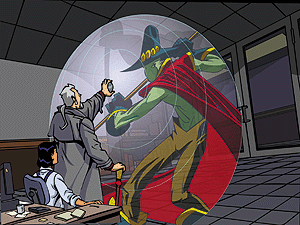How could one of the most promising Internet animation companies come to such a crashing defeat? Brett D. Rogers investigates the unraveling of Stan Lee Media and the growing chorus crying foul.

Less than two years ago, Stan Lee Media rose from the ashes of a bankrupt Marvel, where comic legend Stan Lee created characters such as Spider-Man, the Incredible Hulk and the X-Men. With the creative force of Lee providing guidance, Stan Lee Media quickly earned widespread praise for its innovation in online animation. The company developed a loyal audience for its new characters and attracted high-profile clients like the Backstreet Boys for its animation services. With the wind of a dot-com boom at its back, the company even found itself able to hire away talent from major studios like Disney, attracting animators looking for the creative freedom and energetic environment associated with an Internet start-up. Soon after the launch of its stanlee.net Website in February 2000, Stan Lee Media's market capitalization was well over $300 million, about $100 million more than Marvel Enterprises, where Stan Lee still serves as chairman emeritus.
Like many Internet-related companies, however, Stan Lee Media's perceived success did not accurately reflect conditions behind the scenes. Although the company's stock managed to remain comparatively stable through much of the dot-com stock bubble burst in 2000, Stan Lee Media was running out of money at a blistering pace. While taking in just over $1 million in revenue in its short history, the company tore through over $20 million in cash.

In Stan Lee's comics, when trouble strikes you can always depend on Spider-Man or another familiar hero to save the day. Unfortunately, it's not that easy for his namesake company, which must depend on a different sort of superhero, the high-risk investor.
Putting The Players In Place
In November, it seemed as if Stan Lee Media had found its champion. A bridge financing deal was reached to provide enough backing for the company to continue operating. Along with the deal came a qualification, however. If the company's stock price dropped below a dollar, the financing agreement would not move forward.
The events of the following weeks defy explanation. In the face of the positive financing news, Stan Lee Media's stock price plummeted down from about $8, smashing through the $1 mark on unusually high trading volume, as short-sellers apparently found reward in the carnage.

On December 15, with its stockholders still reeling, Stan Lee Media announced that the plunge scuttled the company's badly needed financing, forcing it to suspend operations and lay off nearly all of its 140 employees.
In a press release, Ken Williams, President and CEO of Stan Lee Media, expressed a glimmer of hope in saying, "We still believe in the fundamentals of our business plan and are proud of the work we have accomplished to date... In the coming weeks we will be focusing on exploring the full range of strategic alternatives available to us in order to maximize shareholder value."
Since learning of the company's shutdown, angry stockholders have directed their ire toward Stan Lee Media insiders. A prime target is Peter F. Paul, a long-time friend of Stan Lee and co-founder of Stan Lee Media who had served as a consultant to the company since its inception. According to Securities and Exchange Commission filings, Paul reported his intention to sell through PFP Family Holdings, his family trust company, over 400,000 shares of Stan Lee Media stock in its final 20 days of trading. A sale of that size in the midst of Stan Lee Media's meltdown would yield estimated proceeds of over $635,000 for PFP, with those sales representing almost 8% of the stock's trading volume over that period.

Since learning of the company's shutdown, angry stockholders have directed their ire toward Stan Lee Media insiders. A prime target is Peter F. Paul, a long-time friend of Stan Lee and co-founder of Stan Lee Media who had served as a consultant to the company since its inception. According to Securities and Exchange Commission filings, Paul reported his intention to sell through PFP Family Holdings, his family trust company, over 400,000 shares of Stan Lee Media stock in its final 20 days of trading. A sale of that size in the midst of Stan Lee Media's meltdown would yield estimated proceeds of over $635,000 for PFP, with those sales representing almost 8% of the stock's trading volume over that period.
When Stan Lee Media's stock price made its final plunge to 13 cents on December 18, NASDAQ halted trading of the company's shares. Shortly after, the Securities and Exchange Commission opened an informal inquiry into the trading of the company's stock "by certain individuals and entities."
Seven Stan Lee Media insiders, including Devendra Mishra, president of the company's international unit, filed to sell approximately $2.1 million worth of stock in the company's final 20 days of trading. As of press time, with trading in the company's stock still halted, Stan Lee Media's total remaining value in terms of market capitalization is only about $1.69 million.

The Rules and Regs
Stock sales by insiders of a publicly traded company are common, legal occurrences when properly completed. However, a company insider may be in violation of the Securities Exchange Act if he or she buys or sells stock in a company while in possession of non-public information that would be considered important to a reasonable investor. An insider who knows material, non-public information about a company has two choices: either disclose the information to the public, or refrain from trading. Additionally, if an insider who holds more than 10% of a corporation's stock buys and then sells within a six month period, he or she must repay all of the profits realized to the company.
Violating insider trading laws can result in a wide range of punishments, including criminal liability, civil penalties and private suits. A person who has been harmed by illegal insider trading has the right to bring a private civil suit against the insider for damages.
While at this stage there is no indication that any insiders at Stan Lee Media violated federal securities law, it is likely that the unusual timing and size of insider sales of the company's stock will be an issue the SEC examines in its investigation.
In a release announcing the SEC probe, Stan Lee Media reported that it had terminated the employment of Stephen Gordon, executive vice president of operations, as well as Peter F. Paul. In addition, the company had uncovered "evidence of possible misuse of company funds by former members of its management team."
Moreover, the company will not comment about the existence of any connection between the discharge of Paul and Gordon, the SEC inquiry and the internal investigation.
A Thickening Plot
What went wrong? What led to the discord between Paul, Gordon and Stan Lee Media's management? What made a company co-founder contribute to the downfall of Stan Lee Media's financing package by declaring his intention to dump a portion of his shares at such a vulnerable time? The answers remain unclear.
In a statement to Dow Jones Newswire, Paul defended his actions, saying he "never intended to sell any stock," and that the shares sold were liquidated as security for a loan. Paul also criticized the methods used by Stan Lee Media to raise money, saying they made the company's stock vulnerable to short-selling by investors.
Regardless of the reason for Paul's trades, Stan Lee Media's flurry of insider sales certainly had a negative impact on the stock's price. Insider sales are a valuable and frequently used tool in assessing the health of a company and the sustainability of that company's stock price. Investors who watched the company's co-founder and second largest shareholder, along with a company officer and five other insiders, sell heavily into weakness in Stan Lee Media's share price must have thought twice about holding onto their own shares.
As more details surrounding the Stan Lee Media nose-dive are uncovered, Paul is likely to remain at the center of controversy. Last August, as Paul organized a massive campaign fundraiser for Hillary Rodham Clinton, the Washington Post exposed Paul as a convicted felon who two decades ago served three years in prison and had his license to practice law suspended after he was convicted of cocaine possession and attempting to defraud the Cuban government of almost $9 million.

A Slight Hope?
While Rick Madden, Stan Lee Media's general counsel, told Dow Jones Newswire that Paul's criminal past did "not directly" contribute to his termination, Williams stated that Paul was "very definitely [fired] for cause," and is "certainly a target" of the company's internal investigation.
It is particularly important that the company claims the dismissal of Paul was "for cause." A March 2000 SEC filing made by the company states that if Paraversal, the company through which Paul provided consulting services to Stan Lee Media, was terminated for "any reason other than for cause or for death and disability, Paraversal will be entitled to a lump sum payment of $1,000,000."
Paul's employment agreement with Stan Lee Media defines "cause" as "(a) willful and repeated failure to comply with the lawful directions of the Board of Directors; (b) gross negligence or willful misconduct in the performance of Consultant's duties to the Company; or (c) conviction of any act of fraud against, or misappropriation of material property belonging to the Company, conviction of any criminal statute constituting a misdemeanor involving moral turpitude or conviction of a felony, chronic alcoholism or drug addiction."

Stan Lee Media was just beginning to develop a core audience when the strange events of November and December 2000 pulled the plug. The popularity of its 7th Portal franchise earned the company a movie deal and a promising 3-D amusement park ride. Unless favorable financing is secured, Stan Lee Media's ambitious plan to use the Internet as a springboard for its creations into the more profitable areas of licensing and merchandising will remain untested.
Williams, speaking by telephone with AWN, says there are still "good prospects" for his company and that he and the remaining core executive group, "continue to actively pursue" deals to resurrect the company. Beyond that, Williams declined to comment, citing the sensitive nature of his company's efforts to emerge from recent events.
In the coming months, while the rest of the online animation industry watches events unfold with intense interest, we'll find out if there will be any new adventures for Stan Lee Media, or if the last panel of this Lee creation has already been inked with a final "The End."
Brett Rogers is a freelance writer and law student based in Baltimore.







